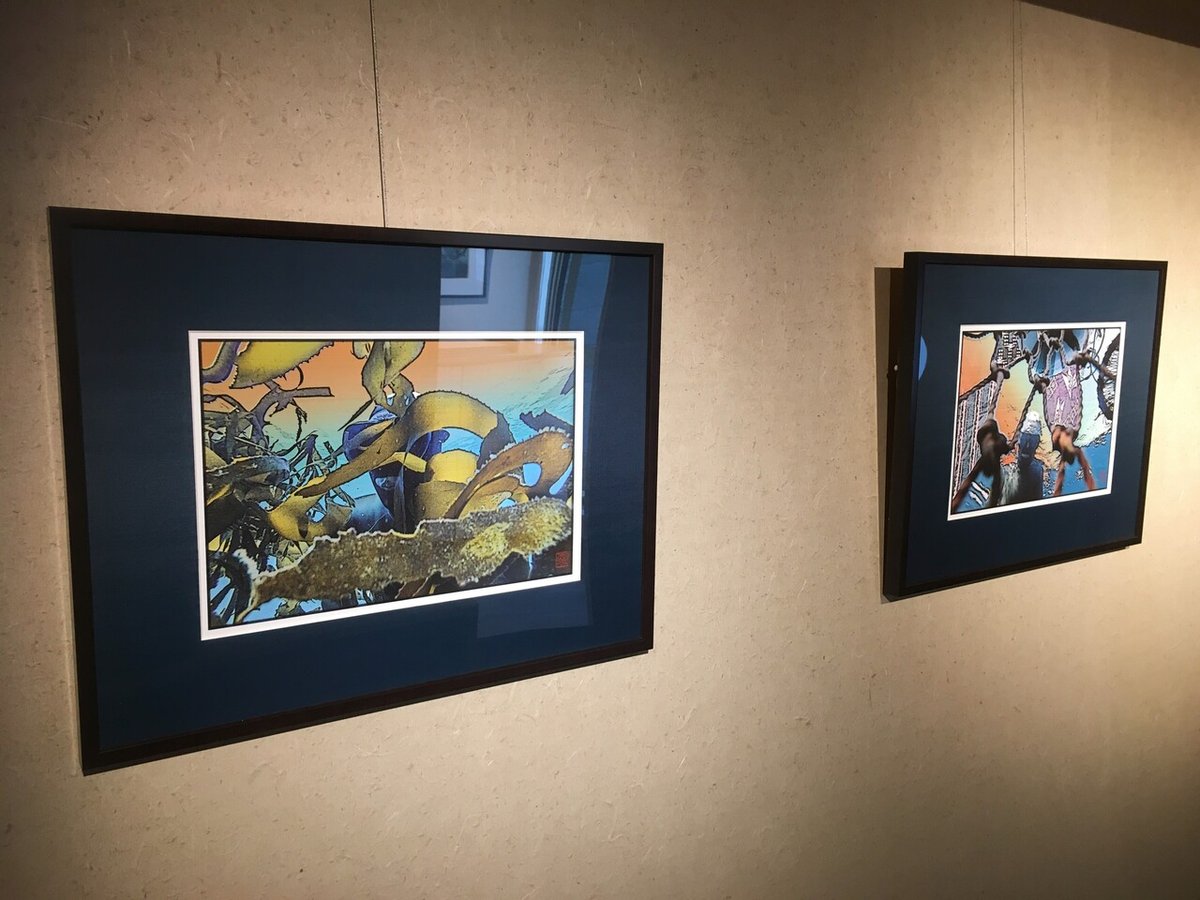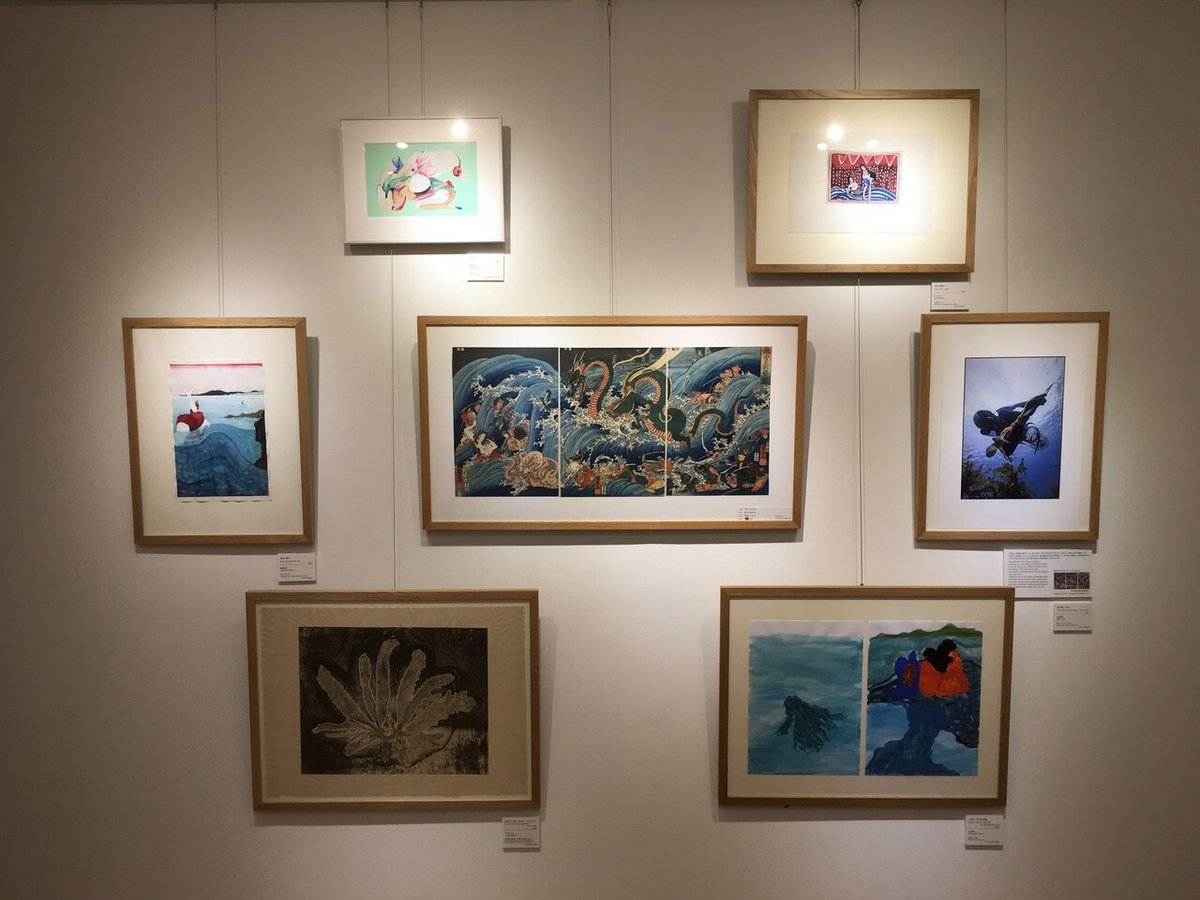
神保町から鳥羽紀行 「自然とともに生きる 海女とアーティスト 昔と今。石鏡町と神保町にダイブ!」
Bilingual Review. Scroll down for English.
「自然とともに生きる 海女とアーティスト 昔と今。石鏡町と神保町にダイブ!」は、三重県内でも特に海女が多い三重県鳥羽市石鏡町(いじかちょう)と、東京都千代田区神保町にある6箇所の古書店やギャラリーを会場に、2020年7月18日から2021年3月31日に開催されたアートプロジェクトだ。このアートプロジェクトには6名のアーティストが参加しており、それぞれが石鏡町の海女と神保町にある海女の浮世絵からインスピレーションを受けて制作した作品が展示された。今回はコロナ禍ということもあり、神保町会場(会期:2021年3月16日から同月31日)のみを周ってきた。
私は2017年から2019年にかけて鳥羽市内で開催されたアートプロジェクトへの参加や、それを契機に鳥羽市のなかまち商店街で自主企画展示を行なってきた。今回の作品展示を見て回っていると、鳥羽で見聞きしたことが思い出されてきた。

▲展覧会のチラシ
2つを繋ぐアートプロジェクト
神保町駅に到着し、はじめに原書房へ。店へ入り2階へ上がると、そこは壁中に様々な題材の浮世絵や近代の版画が掛けられ、その一角に歌川豊国の浮世絵《光氏磯辺遊 其の三》などと稲垣美侑さんの水彩画作品《海女Scenery of Ama》が展示されていた。
浮世絵には海中に潜って仕事をする海女と、陸に上がって休む海女が平面的に重なるレイヤーの中に描かれている。現代の海女はウェットスーツを着て海に潜るのだが、江戸時代の浮世絵では襦袢のような薄い着物を着ている様子がわかる。
稲垣さんの作品では、海女の道具や着衣といったモチーフに焦点を当て、独自のタッチと水彩画の技法で描いている。

▲原書房2階

▲歌川豊国《光氏磯辺遊 其の三》

▲稲垣美侑 《海女Scenery of Ama》
次に山田ビル2階「山田書店美術部」へ。ここでは(三代)歌川豊国の浮世絵《光氏磯辺遊の図》と荻野夕奈さんの作品が展示されていた。
この浮世絵には、伊勢市の二見浦と見られる場所で漁をする海女の様子が描かれている。画面左側には、岩の上に立つ海女が一人と、アワビを採ってきたもう一人が海面から顔を出している。画面中央には採ってきたタコが海へ逃げようとしているのを画面右から海女が走って追いかけてくる姿が。
荻野さんの作品《d-270221_1》には、浮世絵の中で岩の上に立つ海女の頭部が描かれているのだが、その表情は読めない。しかし、その顔をじっと見ていると、海女が海で命がけで漁をする過酷さや海や海女小屋(海女が漁の後に休む小屋)での日常が想像される。

▲山田書店美術部

▲(三代)歌川豊国《光氏磯辺遊の図

▲荻野夕奈《d-270221_1》
ここまでの作品を見て、本アートプロジェクトは江戸時代と現代という時間的、石鏡町と神保町という場所的に離れた2つを参加アーティストの視点と作品制作を通して繋がっていることがわかる。また、アートプロジェクトを通して海女とアーティストがコラボレーションし、ここに至るまで両者の間で多くのコミュニケーションの場が持たれたのではないかと想像した。
「海女」という仕事
私が初めて海女に出会ったのは、2018年の夏に鳥羽市安楽島町を訪れた際だった。世間話中に一人の海女さんが「明日も海に入れるから潜らなきゃ」と何気なく話し、また聞いている人も極自然に受け止めていた。この様子に私は少し驚いた。というのも、その話し方が般的に人が「明日は月曜日だから学校・仕事に行かなきゃ」と言うのと同じような感じの話し方だったからだ。これは、鳥羽では海女は馴染み深い職業なのだと実感した瞬間だった。

▲2019年、安楽島町にて
本展覧会にも、現役の海女でフォトグラファーの大野愛子さんも参加していた。
五拾画廊では、大野さんの写真作品《もうじき半魚人》などが展示されていた。大野さんは以前、鳥羽市の地域おこし協力隊で海女として活動し、協力隊卒業後も海女とフォトグラファーを続けているそうだ。大野さんの作品は、現役の海女ならではの海の中での見え方や、生い茂った海藻に阻まれて獲物がよく見えないといった「海女あるある」を表現したもの。色鮮やかにコラージュされた写真から、海中での仕事の様子がユーモアとともに伝わってくる。私たちが普段見ることのできない海中での日常がそこに写し出されていた。

▲大野愛子《もうじき半魚人》

▲海女あるあるを写した写真作品
アーティストたちの鳥羽滞在の経験
今回、オーストラリアから参加したゾイ・ポーターさん。ゾイさんは数年前にアートば(本展覧会の企画者リンダ・デニスさんが運営する鳥羽市内の滞在・ギャラリー施設)で滞在制作をした。その展覧会では海産物を日本で手に入れた和紙と墨で描いたシリーズと、落ち着いた色彩と鳥羽で見た海藻や海女道具を構成し絵画が展示されていた。
今回出品した作品は《海女と妖怪》。ゾイさんがインスピレーションを受けた歌川国芳の《艶勢喜雑誌》は奇妙ともひょうきんとも受け取れるポーズで海女を見る妖怪と、画面に大胆に描かれた着物の模様で構成されている。一方、ゾイさんの作品では海女と妖怪の姿は似ているが、その周りの風景や模様がどこかアボリジニ絵画の色彩や模様に似ている。鳥羽を訪れた経験と、自身の背景が絵画の中で再構成されている。

▲歌川国芳《艶勢喜雑誌》

▲(左)ゾイ・ポーター《海女と妖怪》
今回の参加アーティストの中で最年少の北村芽子さんは以前、リンダさんが企画した「鳥羽ストーリーズ・アートプロジェクト『安楽島』」(2019年、安楽島町)で鳥羽に滞在した際に、地元に残る神話をもとにしたウォールアートを防波堤に描いた。また、2021年3月に開催された五美術大学連合卒業制作展では自身の内にある愛情についてをペインティング、映像、詩で表現するなど、常に様々な技法に挑戦していることが見受けられる。
本展覧会では、山田ビル7階のギャラリーそうめい堂では軽やかなタッチで描かれた二部作《ワカメ姫と遊覧》を展示。ダイナミックな作品を制作する北村さんの作品の中ではおとなしい印象を受けたが、公式Facebookの写真には石鏡町会場では大胆にも船にペインティングをしている様子が掲載されており、《ワカメ姫と遊覧》は石鏡町の作品と合わせて鑑賞したいと思わせるものだった。

▲ギャラリーそうめい堂

▲北村芽子《ワカメ姫と遊覧》
アーティストそれぞれの鳥羽への滞在経験が今回の作品から感じ取れた。そして、私自身も作品を鑑賞しながら自然と鳥羽に意識が向かっていた。
海藻は海の保育園
私が鳥羽滞在中に地元の方から聞いた「海藻は海の保育園です。」という言葉が非常に印象に残っている。海洋に詳しい方はご存知かもしれないが、多くの魚は海藻に卵を産み、稚魚は海藻の森の中で育つ。つまり、海藻が豊富な海は環境が豊かで、海産物も豊富ということだ。しかし、近年は海水温が上昇し、海藻が植生できる環境が整わなくなってきている。そのため、鳥羽市内の海岸沿いの地域では子ども達に海藻の役割とその重要さをワークショップを通して伝えられるなど、将来の海洋環境を守る活動がされている。
本アートプロジェクトを企画したリンダ・デニスさんの海藻や海女が獲物を入れる道具「すかり」をエンボスの版画作品。この海藻は大野さんが採ってきたものだそう。作品に採ることと育てること。持続可能な漁をする地元の方々の思いを受け取ったリンダさんの考えが、海藻をそのまま版画にしたこの作品に刻まれていると感じた。

▲大屋書房

▲リンダ・デニス 《海女のこんせき:あらめ1(ソフトグランド)》

▲プロジェクトの企画者リンダさん
最後に。ひじきを食べながら
最初に訪れた原書房の方から「是非、どうぞ」と手渡されたのは「海女もん 天然ひじき」。なんと、各展示場所で無料で鳥羽のひじきが配布されていた。展覧会マップとひじきを片手に神保町の交差点にいる自分…。その姿を俯瞰で想像してみると何となくシュールだが、このひじきを持っていればいつもは入りにくく感じる古書店(今回の展示場所)にも入りやすくなる、まるでこの展覧会を周るためのパスポートのようだった。そして、家に帰ってひじきご飯にして美味しくいただいきながら、展覧会に行ったことを思い出した。
このプロジェクトは、リンダさんが続けてきた鳥羽でのアート活動、特に「アートば」での展覧会や、リンダさん人と人を繋ぐ活動が詰まったものだと感じた。石鏡町にある作品はしばらく残されるそうなので、時期を見てぜひ行ってみたい。
※石鏡町の作品展示詳細は「海女とアーティスト」の公式Facebookページをご覧だくさい。

展覧会情報
「自然とともに生きる 海女とアーティスト 昔と今。石鏡町と神保町にダイブ!」
キュレーション:リンダ・デニス
ディレクション:リンダ・デニス(女子美術大学助教授)
石原真伊(鳥羽市立 海の博物館)
開催期間:2020年7月18日〜2021年3月31日(神保町会場は2021年3月16日〜同月31日)
場所:三重県鳥羽市石鏡町と東京都千代田区
主催:石鏡旅館組合、鳥羽市立海の博物館、鳥羽市
協賛・協力:石鏡町内会、鳥羽市磯部漁協石鏡支所、鳥羽市観光協会、三重大学海女研究センター、タッチ・ベース・クリエイティブ・ネットワーク
Facebook:https://www.facebook.com/amadivers.and.artists
Toba Travelogue from Jimbocho“Ama Divers & Artists. Then & Now. Dive into Ijikacho and Jimbocho!”
“Ama Divers & Artists. Then & Now. Dive into Ijikacho and Jimbocho!” was an art project held from July 18, 2020 to March 31, 2021 at six rare bookstores and galleries in Jimbocho, Chiyoda-ku, Tokyo, and in various locations in Ijikacho, Toba City, Mie Prefecture, where there are many ama divers. Six artists participated in this art project, and each of them exhibited works inspired by historic Ukiyo-e prints of ama divers, and contemporary divers of Ijikacho This time, due to restrictions related to Covid-19, I was only able to visit the Jimbocho venues (exhibition period: March 16 to 31, 2021).
I had previously participated in art projects held in Toba City from 2017 to 2019, as well as holding an independent exhibition at the Nakamachi area in Toba City. As I looked around the Jimbocho exhibition, I was reminded of what I had seen and heard in Toba.

▲Exhibition Map
An art project to connect the two
Arriving at Jimbocho Station, I first went to Hara Shobo. As I entered the store and went upstairs, I found the walls covered with Ukiyo-e and modern prints of various subjects, including Toyokuni Utagawa's Ukiyo-e "Mitsuuji Isobeasobi Sonosan" and Miyuki Inagaki's watercolor work "Scenery of Ama“.
Ukiyo-e prints depict divers working in the sea and divers resting on land in flat, overlapping layers. Modern divers wear wetsuits to dive into the sea, while Ukiyo-e from the Edo period show them wearing thin kimonos that look like lintels.
Inagaki's works focus on motifs such as divers' tools and clothes and depict them with her unique touch and watercolor technique.

▲Hara Shobo

▲Toyokuni Utagawa "Mitsuuji Isobeasobi Sonosan"

▲Miyuki Inagaki "Scenery of Ama"
Next, I went to Yamada Shoten on the second floor of Yamada Building. On display here was an Ukiyo-e painting by Utagawa Toyokuni, "Mitsuuji Isobeasobi no Zu" and works by Yuna Ogino.
This Ukiyo-e depicts a group of divers fishing at what appears to be Futamiura in Ise City. On the left side of the picture, one of the divers is standing on a rock, and the other is peeking out of the water holding an abalone shell. In the center of the picture, a diver runs after an octopus from the right side of the picture as it tries to escape into the sea.
Ogino's work "d-270221_1" depicts the head of a diver standing on a rock in an Ukiyo-e, but we cannot read the expression on her face. However, when we stare at the face, we can imagine the harshness of divers risking their lives to fish in the sea, as well as their daily lives in the sea and in the divers' ama-huts (huts where divers rest after fishing).

▲Yamada Shoten

▲Toyokuni Utagawa "Mitsuuji Isobeasobi no Zu"

▲Yuna Ogino "d-270221_1"
Looking at the artworks so far, it is clear that this art project connects the Edo period and the present day, which are separated in time, and Ijikacho and Jimbocho areas, which are separated geographically, through the perspectives of the participating artists and the creation of their artworks. In addition, I imagine that the collaboration between the divers and the artists through the art project has created many opportunities for communication between them.
The job of a "diver”
he first time I met divers was when I visited the town of Arashima, Toba City, in the summer of 2018. During small talk, one of the ama divers casually said, "We can enter the sea again tomorrow, so I have to dive” and the people listening took it quite naturally. I was a little surprised by this, because the way she spoke was similar to the way people generally say, "Tomorrow is Monday, so I have to go to school or work. This was the moment when I realized that being a diver is a common profession in Toba.

▲Arashima, 2019
Aiko Ohno, an active ama diver and photographer, also participated in this exhibition.
Ohno's photographic work, "Will Be A Mermaid In The Near Future?" was on display at Fifty-Gallery. Ohno used to work as a diver in Toba City's Community Development Cooperation Corps and has continued to work as a diver and photographer since graduating from the Corps. Ohno's work expresses "a certain way of being a diver," such as the way only an active diver can view the sea, or the fact that she cannot see her prey clearly because of the thick seaweed. The vividly colored collage of photographs conveys the humor of working under the sea. The photographs show the daily life of divers that we cannot usually see under the sea.

▲Aiko Ohno Will Be A Mermaid In The Near Future?

▲A photographic work depicting Ama
Artists' Experiences in Toba
Zoe Porter, participated in this exhibition from Australia. Zoe had a residency at ARToba (a residency and gallery facility in Toba City run by Linda Dennis, a co-organizer of this exhibition) a few years ago. In that exhibition, she exhibited a series of paintings of marine products drawn on Japanese paper with ink that she had obtained in Japan, and paintings with compositions in subdued colors of seaweed and divers' tools that she had seen in Toba.
One of her works on display this time was "Ama & Yokai". Zoe was inspired by Utagawa Kuniyoshi's "Enseiki zasshi," ukiyo-e, which depicts a hairy figure looking at an ama diver in a pose that can be taken as both strange and funny, with bold patterns of kimono. On the other hand, in Zoe's work, the appearance of the ama and the figure are similar, but the surrounding scenery and patterns somewhat resemble the colors and patterns of Aboriginal paintings. Her experience of visiting Toba and her own background seem to be reconstructed in her paintings.

▲Kuniyoshi Utagawa "Enseiki zasshi"

▲Left side of photo :Zoe Porter "Ama & Yokai"
Meiko Kitamura, the youngest of the participating artists, previously painted a mural based on a local myth on a breakwater wall, when she stayed in Toba for the Toba Stories Art Project "Arashima" (2019, Arashimacho) organized by Linda Dennis. She also expressed her inner love through painting, video, and poetry at the Joint Graduation Exhibition of 5 Art Universities in Tokyo held in March 2021, showing that she is always challenging various techniques.
In this exhibition, the diptych "Diptych: Princess Wakame and The Pleasure Cruise" painted with a light touch was exhibited at Gallery Soumei-do on the 7th floor of Yamada Building. Although it gave me the impression of a quiet work among the dynamic works of Kitamura, the photos on official project Facebook page showed her boldly painting a boat at the Ijikacho venue, which made me want to view "Diptych: Princess Wakame and The Pleasure Cruise" together with her works in Ijikacho.

▲Gallery Soumei-do

▲Meiko Kitamura " Diptych: Princess Wakame and The Pleasure Cruise"
I could feel each artist's experience of staying in Toba in their works. As I watched the works, my mind naturally drifted to Toba.
Seaweed is nursery of the sea
During my stay in Toba, I was told by a local that "seaweed is nursery of the sea ". I was very much impressed by this phrase. As those who are familiar with the ocean may know, many fish lay their eggs in seaweed, and the young fish grow up in the forest of seaweed. In other words, a sea rich in seaweed means a rich environment and abundant marine products. In recent years, however, seawater temperatures have been rising, and the environment for seaweed vegetation is becoming less and less favorable. Therefore, in the coastal areas of Toba City, there are activities to protect the marine environment for the future, such as teaching children about the role and importance of seaweed through workshops.
In the Jimbocho exhibition, there are copperplate print works of seaweed and "sukari", bags used by divers to store their catch, by Linda Dennis, who curated this art project. The seaweed was collected by Aiko Ohno. The work is about gathering and growing. In particular, I felt that Linda's thoughts regarding the local people's ideas of sustainable fishing were engraved in a work, which was a print made directly from seaweed.

▲Ohya Shobo

▲Linda Dennis "Traces of Ama: Arame Seaweed 1 (soft ground)"

▲Linda, the project co-director
Finally. While eating hijki seaweed.
The first thing I was handed by the staff at Hara Shobo was "Ama Mon Natural Hijiki", a packet of dried hijiki seaweed harvested by ama divers. To my surprise, Toba's hijiki seaweed was being distributed free of charge at each exhibition location. So I stood at the busy Jimbocho intersection with the exhibition map and hijiki in hand.... It was like a passport to the exhibition. After returning home and was eating the delicious hijiki seaweed with rice, I enjoyed recalling my trip to the exhibition.
I felt that this project was the culmination of Linda Dennis’s art activities in Toba, especially her exhibitions at "ARToba" and her activities aiming to connect people with each other. I hear that the works in Ijikacho will remain for a while, so I would like to visit there when the time is right.
For more information about the exhibition in Ijikacho, please visit the official Facebook page.

Infomation
“Ama Divers & Artists. Then & Now. Dive into Ijikacho and Jimbocho!”
Curation: Linda DENNIS
Co-Directors: – Linda DENNIS (Joshibi University Associate Professor)
– ISHIHARA Mai (Toba Sea-Folk Museum)
Co-Organization: Ijika Ryokan Association, Toba Sea-Fork Museum, Toba City
Cooperation: Ijika Neighborhood Association, Fisheries Cooperative Ijika, Toba City Association, Mie University AMA Research Center, Touch Base Creative Network
この記事が気に入ったらサポートをしてみませんか?
